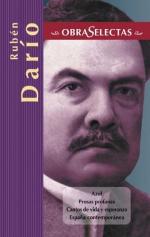|
This section contains 3,159 words (approx. 11 pages at 300 words per page) |

|
SOURCE: "Woman as Image in Darío's Prosas Profanas," in Romance Quarterly, Vol. 36, No. 3, August, 1989, pp. 281-88.
In the following essay, Davies examines classical and Judeo-Christian images of woman in Prosas profanas, assessing the role of the archetypal female in Darío's verse.
Rubén Darío's Prosas Profanas, first published in Buenos Aires in 1896, was an audacious attempt to introduce the "aristocracia literaria" of European learned culture into what Darío considered a Philistine South America. It is significant that all but two of the thirty-three poems of the first edition involve gynaecomorphic images. Two-thirds of them take the female figure from Classical myth and the rest from Christian mythology and the Neo-classical reworkings of folk-tale—in short, from the quintessence of Western culture. It was into this highly contrived and erudite framework that Darío introduced the erotic and its apparent rejection of the narrow-minded, hypocritical...
|
This section contains 3,159 words (approx. 11 pages at 300 words per page) |

|


